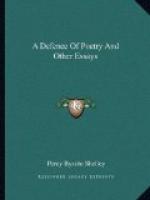In the youth of the world, men dance and sing and imitate natural objects, observing in these actions, as in all others, a certain rhythm or order. And, although all men observe a similar, they observe not the same order, in the motions of the dance, in the melody of the song, in the combinations of language, in the series of their imitations of natural objects. For there is a certain order or rhythm belonging to each of these classes of mimetic representation, from which the hearer and the spectator receive an intenser and purer pleasure than from any other: the sense of an approximation to this order has been called taste by modern writers. Every man in the infancy of art observes an order which approximates more or less closely to that from which this highest delight results: but the diversity is not sufficiently marked, as that its gradations should be sensible, except in those instances where the predominance of this faculty of approximation to the beautiful (for so we may be permitted to name the relation between this highest pleasure and its cause) is very great. Those in whom it exists in excess are poets, in the most universal sense of the word; and the pleasure resulting from the manner in which they express the influence of society or nature upon their own minds, communicates itself to others, and gathers a sort or reduplication from that community. Their language is vitally metaphorical; that is, it marks the before unapprehended relations of things and perpetuates their apprehension, until the words which represent them become, through time, signs for portions or classes of thoughts instead of pictures of integral thoughts;




